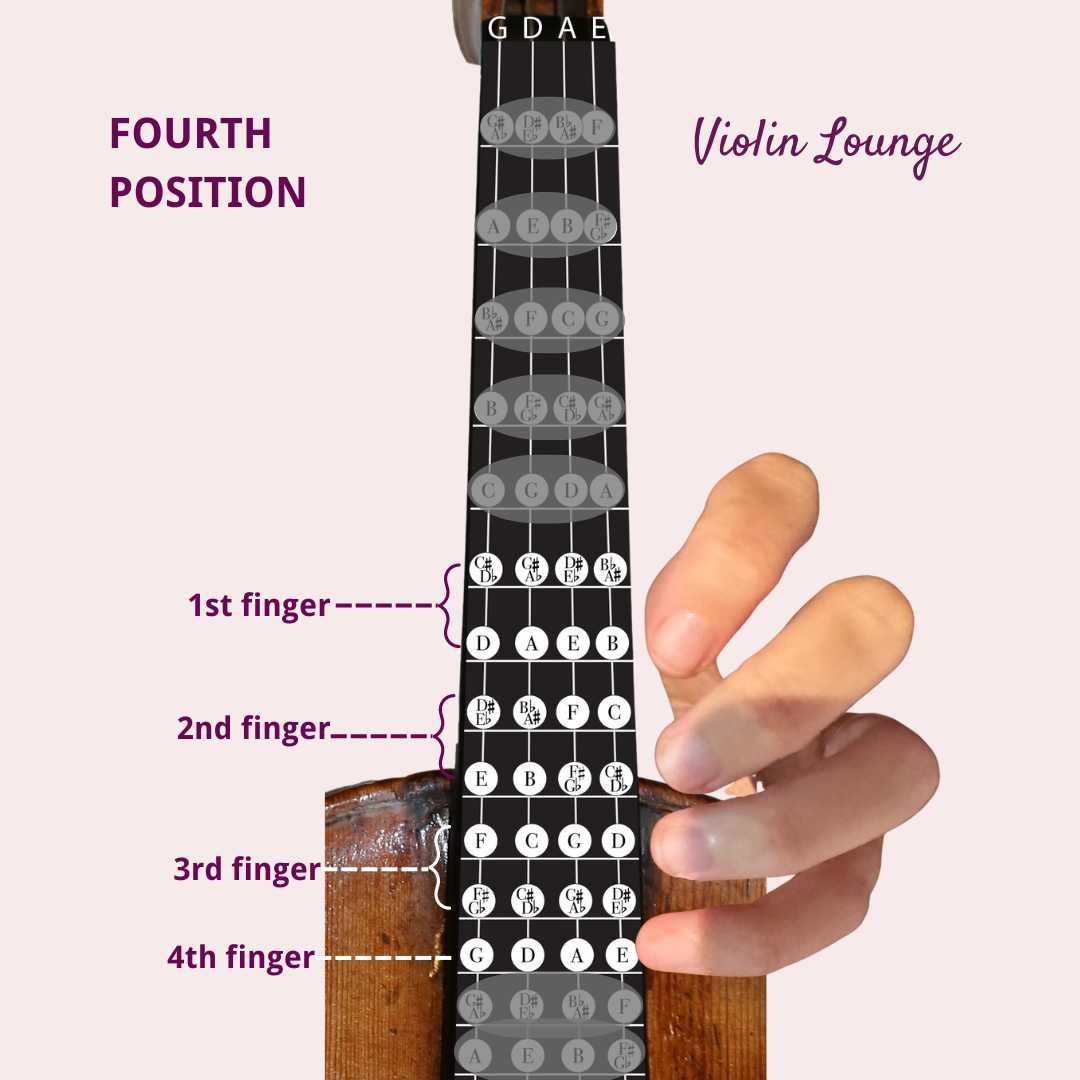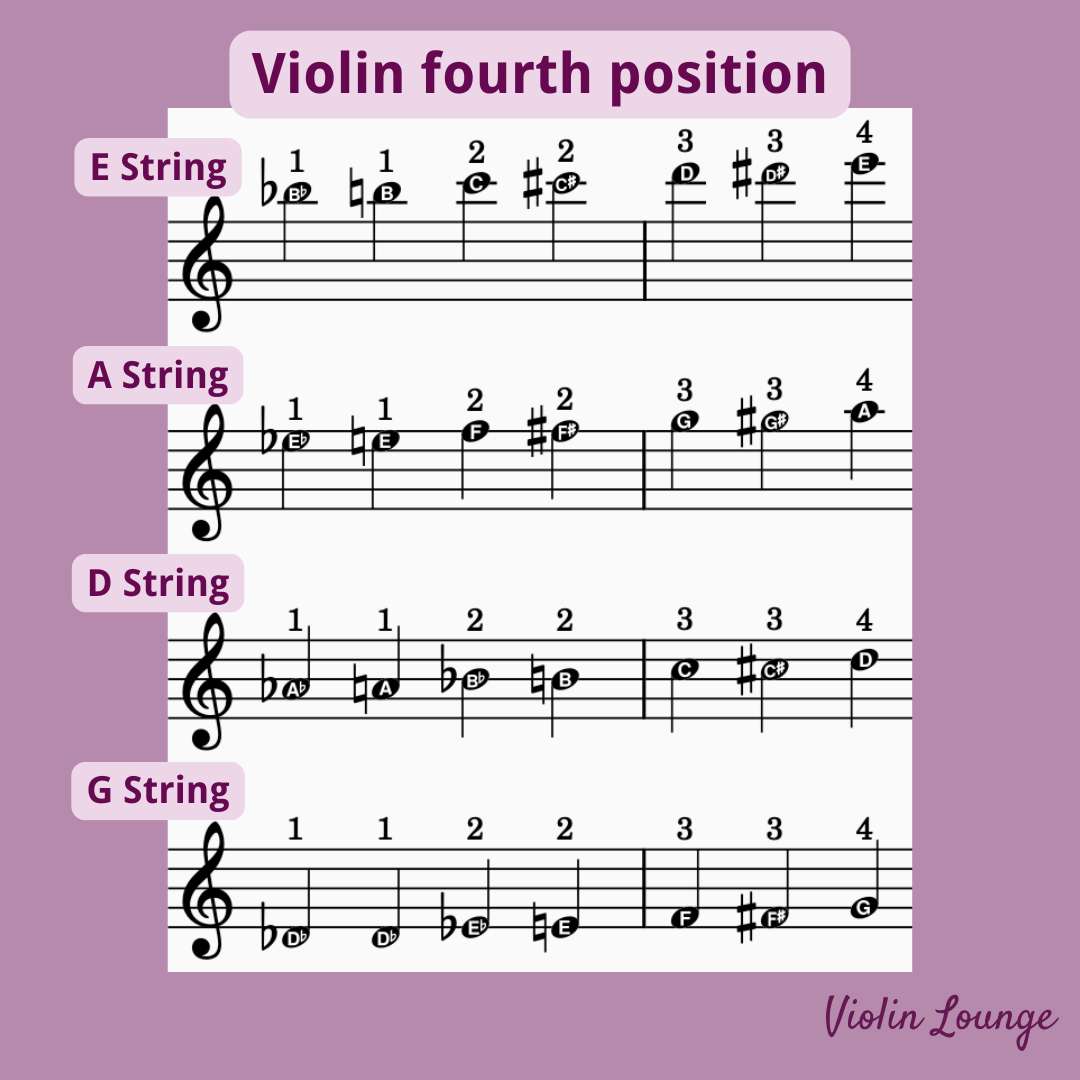Violin Fourth Position – all notes, finger chart and exercises
Fourth Position: the most neglected position on the violin
Most violinists study fourth position after learning first, third, fifth, and second. At this point you should be getting comfortable shifting around the instrument and reading notes with extra ledger lines! However, often fourth position is just skipped or only touched lightly. This results in avoiding the fourth position, while it can come in really handy when selecting fingering for your piece.
May the fourth be with you!
Let’s learn all about the fourth position and polish up this neglected position.
Where does fourth position start?
For many people, fourth position starts about where their wrist starts to touch the rib of the violin. If you practice this over and over, it can be a good shifting tool. However, for a more exact measurement, fourth position starts where regular fourth finger would be in first position. If you’ve already learned fifth, this is a half step lower. Sometimes you might also start from “low” fourth position on Db, Ab, Eb, or Bb. this is a whole step below fifth position. Use the reference point of the soundbox to get secure in the fourth position. Feel the difference between the hand posture of the third and fourth position.
Finger chart of fourth position
Similarly to second position, the hand frame of fourth changes a lot depending on the need. This chart helpfully shows which fingers should be used on each note:

Notes in Fourth Position
The full chromatic range of notes you can play in regular or low fourth position are as follows:
G string: D♭, D, D#/E♭, E, F, F#/G♭, G
D string: A♭, A, A#/B♭, B, C, C#/D♭, D
A string: E♭, E, F, F#/G♭, G, G#/A♭, A
E string: B♭, B, C, C#/D♭, D#/E♭, E
Sheet music of the fourth position
This is what the fourth position notes look like in violin sheet music. I’ve chosen between notes that are enharmonically the same. Of course if a F# is possible, a Gb is possible too (also see the finger chart above).

Example of Fourth Position
The Prelude from J.S. Bach’s famous Partita No. 3 opens in fourth position. In this video of Midori, you can clearly see how she plays the first six notes in fourth before shifting to open E.
Fourth Position in Sheet Music
Here are some etudes and pieces that can help you get comfortable with fourth position:
- Changes of Position and Preparatory Scale Studies, Op. 8 by O. Sevcik
- Introducing the Positions, Vol. 2 by Harvey S. Whistler
- Kreutzer’s Etudes Nos. 8 and 11
- Prelude from J.S. Bach’s Partita No. 3
How to Learn Fourth Position
Although it may seem tricky at first, you will be surprised how useful fourth position is. Like second position, it fills in the passages that are awkward to play in third and fifth. For general shifting tips, check out my articles on third and fifth position. Here’s a few helpful things specific to fourth position:
Depending on the key, fourth position in particular changes a lot between “low” and “regular” fourth position. “Low” is helpful for keys like Bb or Eb Major, while “regular” is great for E Major. You will use fourth position A LOT for these keys.
Practice slide-shifting to fourth positon by playing a one octave scale on each string. For example, on a string play A, B, C#, D in first position, then shift to fourth on E. Your fourth finger will end on A.
Fourth finger in fourth position will land on a harmonic. A harmonic means that you don’t have to press the string down, just touching it gently creates a beautiful clear tone. Use harmonics in fourth position to check if you are in tune.

Hi! I'm Zlata
Classical violinist helping you overcome technical struggles and play with feeling by improving your bow technique.
Learn to play in tune in the fourth position
You might have stumbled upon this blog post, because you discovered that you neglexted the fourth position in your violin studies and want to improve it.
I personally have sort-of-ignored the fourth position and have avoided it for a long time. It took exercises in the style of Paganini to get it solid for me and now I’m happy that I have the fourth position in my tool box. It can come in so handy when choosing fingerings in your pieces.
Great exercises to get reliable intonation in the fourth position are left hand pizzicato exercises, double stop arpeggios, shifting exercises. stretches, glissando scales, artificial harmonics and velocity exercises.
In my online membership Paganini’s Secret, there’s a whole module all about the fourth position which will improve your playing guaranteed. Check it out and register right here.

Zlata, thank you so much for posting this!!!!!! I have been coming along with my playing and there are so many peices that I have had to basically guess or stop playing halfway through because of my unfamiliarity with the 4th position…
Glad it’s helpful!